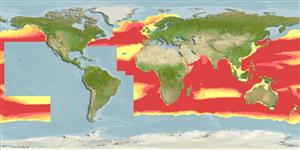Common names from other countries
Environment: milieu / climate zone / depth range / distribution range
Ecologia
Batipelágico; intervalo de profundidade 52 - 4306 m (Ref. 1844). Polar
Eastern Atlantic and Indo-Pacific: Tonga, Melanesia and Pan oceanic.
Length at first maturity / Tamanho / Peso / Idade
Maturity: Lm ? range ? - ? cm
Proboscis very long, swollen proximal to including midpoint, extremely slender (pipette-like) distal to swelling, upturned toward tip. Lateral processes short, well separated. Palps moderately short, little longer than proboscis, distal three segments subequal. Legs very slender, distal segments small, tarsus longer by 1.5 times than short propodus, claw tiny (Ref. 9); Proboscis very slender, medially swollen, tapering distally, slightly upturned (with variation in the low angle of upturn) and much longer than trunk. Palp segment 5 much longer than segment 3, sixth and seventh are subequal, distal 3 much shorter than sixth or seventh and subequal to each other. Legs very slender, tarsus about 1.4 to 2.0 times longer than propodus, terminal claw about half as long as propodus (Ref. 2153).
Bathyal to abyssal (Ref. 19).
Life cycle and mating behavior
Maturidade | Reprodução | Desova | Ovos | Fecundidade | Larvas
Members of the class Pycnogonida are gonochoric and sexually dimorphic. During copulation, male usually suspends itself beneath the female. Fertilization occurs as the eggs leave the female's ovigers. Males brood the egg masses until they hatch. Life cycle: Eggs hatch into protonymphon larva then to adults.
Child, C.A. 1998. (Ref. 9)
Status na Lista Vermelha da IUCN (Ref. 130435)
Status no CITES (Ref. 108899)
Not Evaluated
Not Evaluated
Uso pelos humanos
| FishSource |
Ferramentas
Mais informação
Idade/TamanhoCrescimentoComprimento-pesoComprimento-comprimentoMorfologiaLarvasAbundância
Fontes da internet
Estimates based on models
Preferred temperature
(Ref.
115969): 2.5 - 7.9, mean 4 (based on 2829 cells).
Categoria de preço
Unknown.
